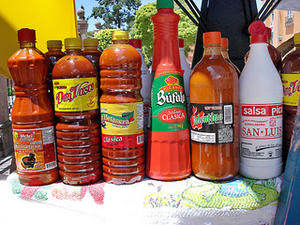Food safetyThe hidden dangers of south-of-the-border hot sauce
In the last decade, the U.S Food and Drug Administration (FDA) issued several warnings about and recalls of imported food products that exceed federal standards for lead. Products containing chili peppers and salt, such as Mexican-style candies, were often suspected as sources of lead contamination. Researchers now find elevated lead levels in some hot sauces imported from Mexico. The researchers urge USDA and the FDA to develop enforceable screening standards for hot sauce.

A group of mexican hot sauces containing high lead content // Source: expedientenoticias.com
In the last decade, the U.S Food and Drug Administration (FDA) issued several warnings about and recalls of imported food products that exceed federal standards for lead.
Products containing chili peppers and salt, such as Mexican-style candies, were often suspected as sources of lead contamination. Work by University of Nevada, Las Vegas (UNLV) researchers and the Southern Nevada Health District led to the removal of imported candies from local store shelves in 2006. In 2010, the FDA issued an alert for the “detention without physical examination of candy due to lead” for thirty types of candies from China, Mexico, and the Philippines.
A UNLV release reports that the UNLV researchers turned their attention to hot sauces, which contain similar ingredients to candy but have not been evaluated by the FDA. Shawn Gerstenberger and Jennifer Berger Ritchie conducted the first known investigation of lead concentrations in hot sauces.
Their results were published in a recent edition of the Journal of Environmental Science and Health, Part B.
Methodology
In this pilot study, twenty-five bottles of imported hot sauces from Mexico and South America were purchased from local ethnic markets, grocery stores, and a swap meet. Product selection included a variety of manufacturers and types, particularly those made in Mexico because of previous lead concerns.
Bottles were shaken for sixty seconds and analyzed for lead concentrations and pH levels. The lead content of the packaging was evaluated (lead content in packaging has been known to leech into and contaminate other food products).
The result
Four brands of hot sauces, or 16 percent, exceeded 0.1 ppm lead, the current FDA standard for unsafe levels of lead in candy. All four of these brands were imported from Mexico, but were from four different manufacturers.
The hot sauces that exceeded the 0.1 ppm lead standard include (note: not all manufacturer names were mentioned in the original study):
- Salsa Picante de Chile Habanero, manufactured by El Yucateco
- El Pato Salsa Picante, manufactured by Walker Foods
- Salsa Habanera, manufactured by Salsas Castillo
- Bufalo Salsa Clasica, manufactured by Herdez
Implications
There is no known safe level for lead exposure, as lead poisoning can affect almost every organ in the body and is absorbed faster by children than adults. In young children, lead poisoning has been known to cause learning disabilities, behavioral problems, and even seizures, comas and death in extreme cases.
Although hot sauce would not intuitively be counted amongst food products highly consumed by children, the study suggests that ethnic and cultural practices must be considered.
If hot sauce is a regular part of a child’s diet, it could contribute to unsafe levels of lead exposure, especially when combined with exposure to lead in the soil, cookware, and candies, or paint manufactured before 1978.
The takeaway
“The results indicate the need for more rigorous screening protocols for products imported in Mexico, including an applicable standard for hot sauce,” Gerstenberger said. “Without enforceable standards for hot sauces and condiments, manufacturers will not be encouraged to improve quality control measures designed to reduce the amounts of lead and other toxic elements before exporting.”
The study also suggests that the USDA and FDA receive support to create and establish additional standards to protect consumers from chemical hazards, such as lead in hot sauces, and enforce or clarify existing standards.
Gerstenberger recommends the adoption of 0.1ppm lead as a standard of unsafe levels for hot sauces until further conclusive evidence supports a different action level. He also says states can adopt policies to reject all imported hot sauces and other food products found to contain detectable concentrations of lead.
— Readmore in Jennifer A. Berger Ritchie & Shawn L. Gerstenberger, “An evaluation of lead concentrations in imported hot sauces,” Journal of Environmental Science and Health, Part B (19 October 2012): 530-38 (DOI: 10.1080/03601234.2013.774226)
